Top 10 African Countries with Highest GDP Growth in 2024
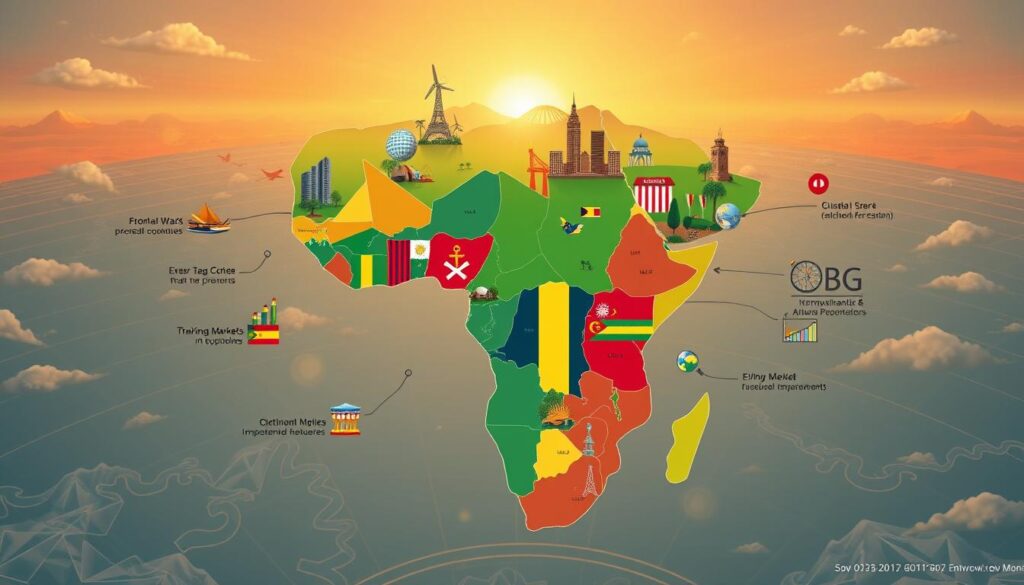
The International Monetary Fund (IMF) World Economic Outlook for April 2024 reveals a significant shift. Nine out of the top twenty economies projected for the fastest growth in 2024 are African nations1. Countries like Niger, Senegal, Libya, Rwanda, Côte d’Ivoire, Djibouti, Ethiopia, The Gambia, and Benin are set to lead the charge2. Notably, Niger is forecasted to be the third-fastest growing economy globally and the fastest in Africa, with a projected real GDP growth rate of 10.4%2. Senegal and Libya are also expected to see robust economic expansions, with growth rates of 8.3% and 7.8% respectively in 20242.
Looking at the global stage, South Africa takes the lead with a projected GDP growth rate of 13.2% in 2024, followed closely by Egypt at 12.3%1. Algeria, Nigeria, and Ethiopia also make the list, showcasing Africa’s economic prowess1.
Key Takeaways
- Nine out of the top 20 fastest-growing economies in 2024 are African countries.
- Niger is projected to be the third-fastest growing economy globally and the fastest in Africa, with a 10.4% GDP growth rate.
- Senegal and Libya are also expected to experience strong economic expansions, with 8.3% and 7.8% GDP growth rates, respectively.
- Several other African nations, including South Africa, Egypt, Algeria, Nigeria, and Ethiopia, are among the top 10 countries with the highest GDP growth rates worldwide.
- The robust economic performance of these African countries highlights the continent’s growing economic potential and resilience.
Overview of Africa’s Economic Growth in 2024
The outlook for Africa’s economic performance in 2024 is cautiously optimistic. The African Development Bank Group’s latest African Economic Outlook indicates that 41 African countries will see stronger growth rates in 2024 than in 20233. The International Monetary Fund (IMF) also forecasts that six of the top 10 performing economies worldwide in 2024 will be from Sub-Saharan Africa3. This positive sentiment reflects the continent’s resilience against various challenges, such as global commodity price fluctuations, political events, climate change impacts, and economic uncertainties that affected many African countries last year.
ALSO READ: Africa’s Economy on the Rise: The Powerhouses Leading the Charge in 2024
Despite these challenges, the projections for 2024 suggest a more optimistic outlook for Africa’s economic performance. The IMF revised Nigeria’s growth forecast for 2024 to 3.1% from the earlier forecast of 3.3% in April3. Sub-Saharan Africa’s growth forecast was decreased to 3.7% from 3.8% in April, mainly due to the revision in Nigeria’s growth outlook3. On the other hand, the IMF projected Ghana’s economy to grow by 2.8% in 2024 and 4.4% in 20253.
| Country | 2020 | 2021 | 2022 | 2023 | 2024 | Five-Year Avg. |
|---|---|---|---|---|---|---|
| Niger | 3.55 | 1.399 | 11.904 | 1.409 | 10.424 | 5.7372 |
| Senegal | 1.342 | 6.54 | 4 | 4.102 | 8.252 | 4.8472 |
| Libya | -29.46 | 28.335 | -8.252 | 10.156 | 7.832 | 1.723 |
| Rwanda | -3.38 | 10.88 | 8.158 | 6.949 | 6.931 | 5.9076 |
| Djibouti | 1.316 | 4.522 | 3.876 | 6.989 | 6.513 | 4.6432 |
| Côte d’Ivoire | 0.701 | 7.062 | 6.862 | 6.2 | 6.5 | 5.465 |
| The Gambia | 0.591 | 5.256 | 4.905 | 5.555 | 6.223 | 4.506 |
| Benin | 3.849 | 7.155 | 6.253 | 5.756 | 6.039 | 5.8104 |
| Togo | 1.976 | 5.991 | 5.811 | 5.4 | 5.3 | 4.8956 |
| Liberia | -2.967 | 5.011 | 4.811 | 4.583 | 5.277 | 3.343 |
| Mauritania | -0.429 | 0.737 | 6.364 | 4.811 | 5.052 | 3.307 |
| Guinea-Bissau | 1.5 | 6.4 | 4.2 | 4.2 | 5 | 4.26 |
| Kenya | -0.273 | 7.59 | 4.847 | 5.507 | 4.974 | 4.529 |
| Mozambique | -1.22 | 2.377 | 4.36 | 6.013 | 4.974 | 3.3008 |
| Tanzania | 4.535 | 4.838 | 4.68 | 5.023 | 5.503 | 4.9158 |
| Uganda | -1.142 | 5.486 | 6.3 | 4.766 | 5.631 | 4.2082 |
| Ethiopia | 6.057 | 6.265 | 6.358 | 7.176 | 6.234 | 6.418 |
| Zambia | -2.785 | 6.235 | 5.25 | 4.33 | 4.715 | 3.549 |
| Democratic Republic of the Congo | 1.671 | 6.037 | 8.774 | 6.14 | 4.699 | 5.4642 |
| Cabo Verde | -20.81 | 5.615 | 17.117 | 4.792 | 4.742 | 2.2922 |
| São Tomé and Principe | 2.625 | 1.899 | 0.065 | -0.3 | 2.9 | 1.4378 |
| Seychelles | -11.74 | 0.554 | 14.978 | 3.679 | 3.229 | 2.1398 |
| South Sudan | -6.494 | 5.329 | -5.186 | -0.07 | 5.603 | -0.1636 |
| Egypt | 3.573 | 3.253 | 6.653 | 3.76 | 2.966 | 4.041 |
| Algeria | -5.017 | 3.805 | 3.616 | 4.184 | 3.848 | 2.0872 |
| Morocco | -7.178 | 8.021 | 1.259 | 3.017 | 3.145 | 1.6528 |
| Tunisia | -8.592 | 4.605 | 2.603 | 0.425 | 1.878 | 0.1838 |
| Sudan | -3.63 | 0.5 | -2.5 | -18.3 | -4.201 | -5.6262 |
| Angola | -5.638 | 1.199 | 3.045 | 0.47 | 2.558 | 0.3268 |
| Ghana | 0.514 | 5.076 | 3.078 | 2.259 | 2.779 | 2.7412 |
| Guinea | 4.704 | 5.583 | 3.972 | 5.7 | 4.074 | 4.8066 |
| Lesotho | -5.303 | 1.7 | 1.6 | 1.877 | 2.378 | 0.4504 |
| Madagascar | -7.138 | 5.74 | 4 | 3.8 | 4.5 | 2.1804 |
| Nigeria | -1.794 | 3.647 | 3.252 | 2.86 | 3.338 | 2.2606 |
| Malawi | 0.913 | 4.567 | 0.8 | 1.6 | 3.3 | 2.236 |
| Burundi | 0.335 | 3.119 | 1.827 | 2.659 | 4.282 | 2.4444 |
| Burkina Faso | 1.922 | 6.938 | 1.78 | 3.561 | 5.464 | 3.933 |
| Central African Republic | 0.959 | 0.983 | 0.472 | 0.727 | 1.269 | 0.882 |
| Cameroon | 0.539 | 3.649 | 3.595 | 3.969 | 4.253 | 3.201 |
| Chad | -2.053 | -0.914 | 3.075 | 4.369 | 2.912 | 1.4778 |
| Comoros | -0.196 | 2 | 2.603 | 2.996 | 3.491 | 2.1788 |
| Republic of the Congo | -6.268 | 1.057 | 1.75 | 4.033 | 4.432 | 1.0008 |
| Equatorial Guinea | -4.788 | -0.377 | 3.246 | -5.947 | 0.467 | -1.4798 |
| Eswatini | -1.56 | 10.683 | 0.476 | 5.133 | 3.699 | 3.6862 |
| Gabon | -1.815 | 1.468 | 3.037 | 2.266 | 2.902 | 1.5716 |
| Mali | -1.244 | 3.053 | 3.475 | 4.5 | 4 | 2.7568 |
| Namibia | -8.101 | 3.525 | 4.56 | 3.154 | 2.65 | 1.1576 |
| Somalia | -2.56 | 3.308 | 2.433 | 2.8 | 3.7 | 1.9362 |
| South Africa | -5.963 | 4.703 | 1.91 | 0.602 | 0.879 | 0.4262 |
| Botswana | -8.726 | 11.867 | 5.782 | 3.245 | 3.574 | 3.1484 |
| Zimbabwe | -7.782 | 8.425 | 6.485 | 5.313 | 3.196 | 3.1274 |
| Eritrea | n/a | n/a | n/a | n/a | n/a | n/a |
| Sierra Leone | -1.969 | 4.105 | 3.458 | 3.392 | 4.005 | 2.5982 |
These projections highlight the diverse economic landscape across the African continent. Some countries are experiencing stronger growth, while others face challenges. The data underscores the need for continued efforts to address the region’s economic hurdles and capitalize on emerging opportunities34.

“The projections for 2024 offer a more optimistic outlook for Africa’s economic performance, despite the various challenges faced by the continent in the previous year.”
Niger’s Economic Surge in 2024
The International Monetary Fund (IMF) initially projected a remarkable economic leap for Niger in 2024, with a forecasted real GDP growth of 10.4%5. This growth rate will catapult Niger to the third-fastest economy globally and the fastest in Africa6. However, recent developments have led to more cautious estimates.
The World Bank has revised its growth projection for Niger in 2024 to a more modest 6.9%, significantly lower than the IMF’s initial forecast. This adjustment reflects the complex challenges facing the country, including political instability following the July 2023 military coup and subsequent diplomatic tensions with neighboring countries.
ALSO READ: A New Dawn in The Sahel: Mali, Burkina Faso, and Niger Forge Path Towards Confederation
Niger’s economic potential is still largely tied to its oil reserves and the recently completed 2,000-kilometer pipeline to Benin6.. This pipeline, designed to increase Niger’s oil production from 20,000 barrels per day to potentially 110,000 barrels per day, represents a significant opportunity for economic growth. However, the project faces several hurdles, including security threats from rebel groups, diplomatic disputes with Benin, and the broader impacts of regional sanctions.
Between 2025 and 2029, Niger’s GDP is expected to expand by about 6% annually6. This economic boom will positively affect Niger’s population, reducing extreme poverty from 52.0% in 2023 to 50.0% by 20265. Yet, Niger faces hurdles, including the adverse effects of ECOWAS sanctions, which have raised living costs and caused electricity shortages5.
| African Countries | GDP Growth (5-Year Average) |
|---|---|
| Niger | 7.9% |
| Côte d’Ivoire | 6.2% |
| Benin | 6.1% |
| Rwanda | 6.0% |
| Djibouti | 5.8% |
Niger’s economic outlook remains optimistic, with oil expected to fuel its growth6. The pipeline project will boost oil exports from 20,000 to 90,000 barrels daily by 20256. This increase will yield around €610 million in tax revenues for Niger by 20256.
“Of the 20 countries with the strongest economic growth in the world in 2024, 11 are African.”6
Niger’s economic transformation showcases its resilience and commitment to sustainable development56. As Niger tackles its economic hurdles, its growth in 2024 and beyond promises a brighter future for its citizens and the wider region.
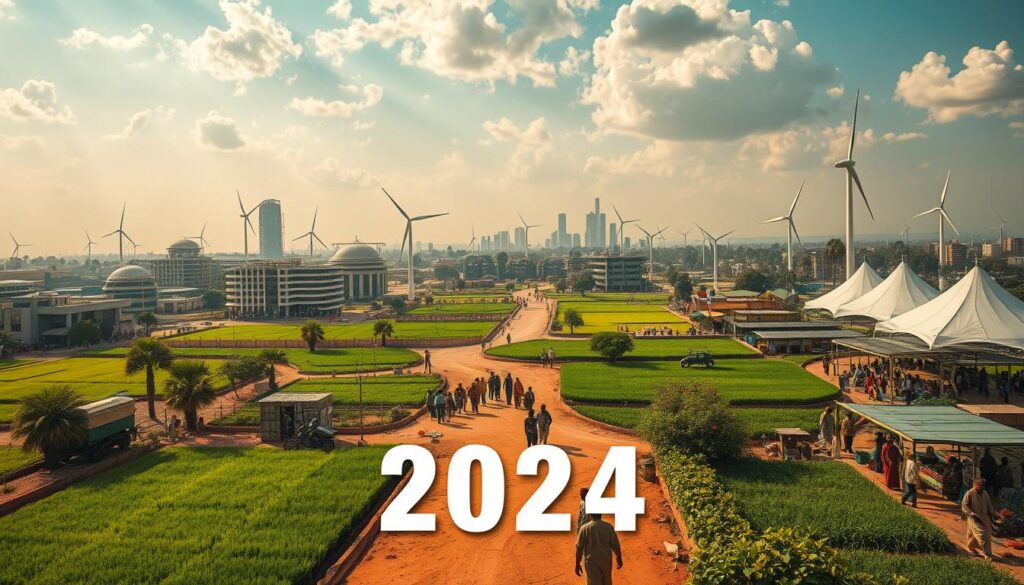
Senegal’s Hydrocarbons Industry Boost
Senegal is set to lead African economies in 2024, with a GDP growth rate of 8.0% in 2023 and a staggering 10.5% in 20247. This growth is mainly fueled by its booming hydrocarbons sector. The sector has seen the discovery of over 40 trillion cubic feet of natural gas between 2014 and 20178.
ALSO READ: Senegal President Bassirou Diomaye Faye Dissolves Parliament. Here’s Why.
Oil and gas projects in Senegal are attracting major investments from global energy giants like BP, Kosmos Energy, and Woodside Energy7. This influx of capital has significantly boosted the country’s economic growth7. Foreign direct investment (FDI) in Senegal has surged from $409 million in 2015 to $2.23 billion in 2021, reflecting growing investor confidence7.
| Country | 5-Year Average GDP Growth (%) |
|---|---|
| Senegal | 5.2% |
| Niger | 6.1% |
| Rwanda | 7.8% |
| Côte d’Ivoire | 6.5% |
| Djibouti | 6.0% |
Senegal’s economy is strengthened by over 300,000 small and medium enterprises (SMEs), adding to its diverse and vibrant economy7. The country’s GDP is split into 50% from services, 25% from industry, and 15% from agriculture7.
Government initiatives, such as President Macky Sall’s Plan for an Emerging Senegal (PSE), have been crucial in driving growth and attracting investments in sectors like transport, energy, agriculture, education, and health7. However, SMEs face challenges in accessing financing due to risk-averse lenders and poor accounting practices7.
Despite these challenges, Senegal is committed to enhancing its private sector. It aims to encourage SMEs to scale, attract investments, and lead in manufacturing7. With ongoing hydrocarbons industry development and a focus on diversification, Senegal is set to solidify its status as a leading African economy7.
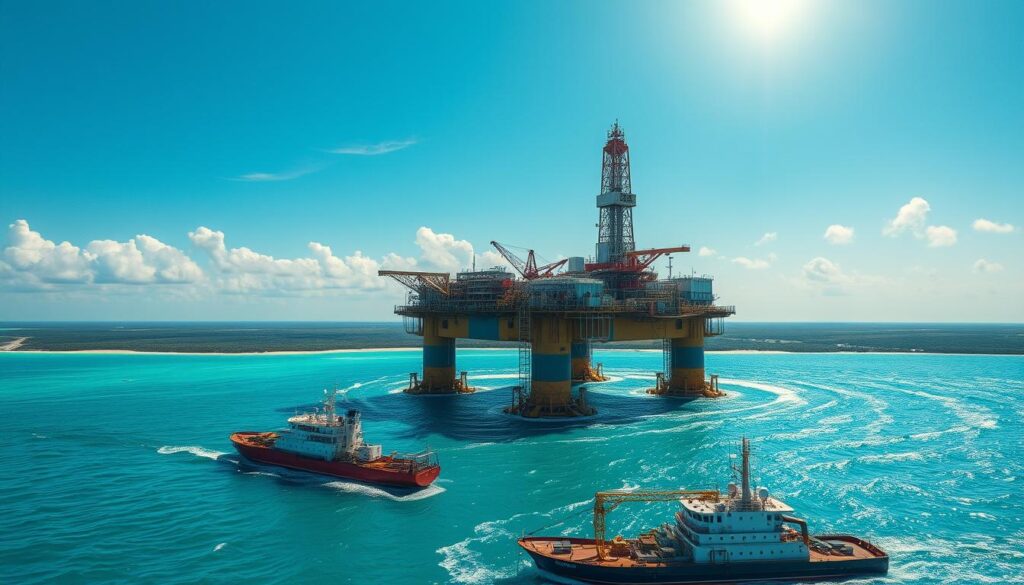
“Senegal’s economic growth is driven by its rapidly expanding hydrocarbons industry, which has attracted significant foreign investments and is expected to continue fueling the country’s prosperity in the years ahead.”
Libya’s Post-Conflict Economic Growth
Libya is on the path to a significant economic rebound, with a GDP growth rate of 7.8% forecasted for 20249. This places Libya as the third-fastest growing economy in Africa, highlighting the nation’s efforts to stabilize its political and security environments9.
The country’s vast natural resources, including nearly 3% of the world’s proven oil and natural gas reserves, are key drivers of its economic growth9. Plans to nearly double oil production by 2025 are expected to boost the energy sector, a crucial part of Libya’s economy9.
| Country | 5-Year Average GDP Growth (%) |
|---|---|
| Equatorial Guinea | 9.2% |
| South Sudan | 8.5% |
| Libya | 7.8% |
| Mauritania | 6.5% |
| Morocco | 5.2% |
Yet, Libya faces significant challenges in its economic recovery. Its public debt is a staggering 77% of GDP and 126% of government revenue9. The unemployment rate is officially 19.6%9. Moreover, over 85% of the workforce is in the public and informal sectors9, emphasizing the need for diversification and private sector growth.
Despite these obstacles, Libya’s economic outlook remains optimistic. This is due to its vast natural resources, ongoing political stability, and the government’s dedication to economic recovery10. Libya is set to become a significant player in Africa’s economic scene as it continues to rebuild and diversify its economy10.
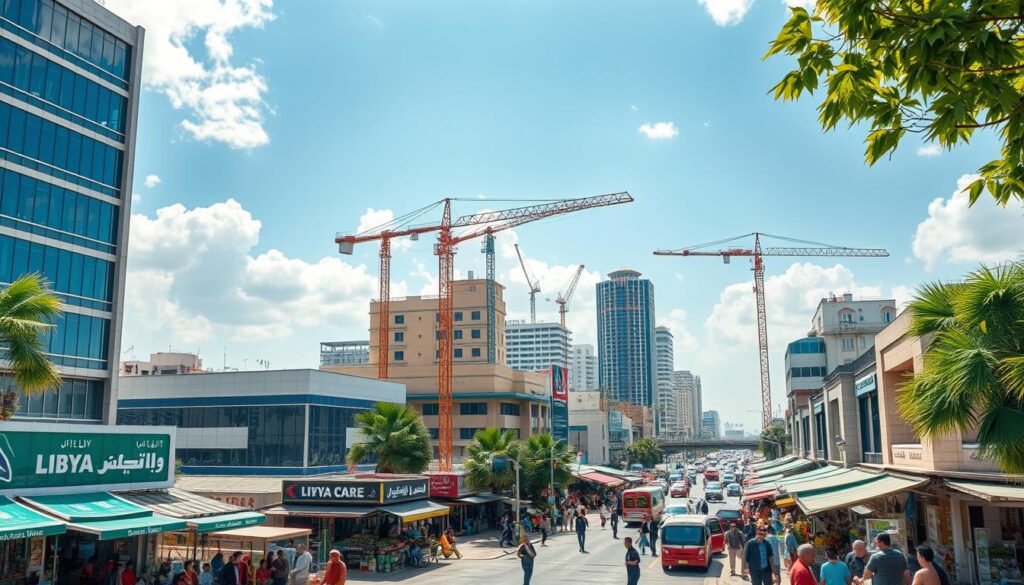
“Libya’s economic growth in 2024 is a testament to the resilience of its people and the determination of its government to rebuild and diversify the economy in the aftermath of the civil war.” –
Rwanda’s Transformational Growth
Rwanda, known as the land of a thousand hills, is rapidly becoming a symbol of economic transformation in Africa. It is set to achieve a GDP growth rate of 6.9% in 202411. This places Rwanda as the fourth-fastest growing economy on the continent. The country’s commitment to strategic development and policy reforms is evident in its drive to diversify its economy and attract foreign investment.
The focus on sectors like technology, tourism, and agriculture11 fuels Rwanda’s economic growth. The energy sector has seen significant advancements, connecting 3.2 million people to electricity in 15 years. This effort has added 358,000 households to the grid and 360,000 to off-grid electricity11. Moreover, 61MW of hydroelectricity has been generated, and an existing hydro station has been rehabilitated, adding 10MW with World Bank support11. Rwanda has also improved its energy sector, with 100% of large and medium-sized customers now connected to advanced metering, reducing commercial losses by 3.39%11.
ALSO READ: Rwanda Makes Remarkable Strides In Its Economy Just 2.5 Decades After A Devastating Genocide
The agricultural sector is another key driver of Rwanda’s economic transformation. The country has developed 18,000 hectares of marshland, hillside, and small-scale irrigation systems and technologies. It has also implemented 61,000 hectares of terraced hills and land husbandry technologies to control erosion and enhance productivity11. Furthermore, 49 Water Users Associations have been created for the sustainable operation and maintenance of irrigation systems11.
Rwanda’s focus on human capital development is noteworthy. The World Bank has provided $1 billion for the education sector in the past seven years. This has ensured that two million 5-14-year-old children can now access a school within a 2 km radius of their home11. The health sector has also been a beneficiary, with 5.2 million people (40% of the population) receiving critical health and nutrition services. This has led to a remarkable reduction in the stunting rate among children under five years of age in the 13 targeted districts11.
Rwanda’s transformational growth is supported by its strategic vision, as outlined in its Vision 2050 plan. Despite being classified as a low-income country by the World Bank, Rwanda ranks 38th in the World Bank’s Ease of Doing Business Index in 202012. Vision 2050 aims to elevate Rwanda to upper-middle-income status by 2035 and high-income status by 2050. It focuses on five key pillars: human development, competitiveness and integration, agriculture for wealth creation, urbanization and agglomeration, and accountable and capable state institutions12.
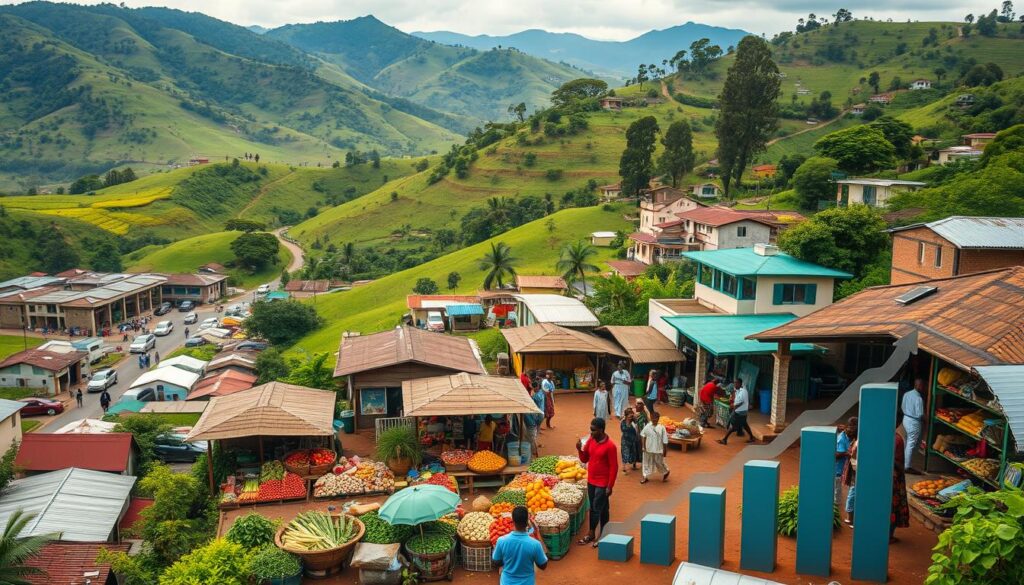
Rwanda’s economic transformation showcases its unwavering commitment to sustainable development, strategic policymaking, and the effective use of international partnerships and funding. As the nation continues to drive its economic growth, it serves as an inspiring model for other African countries aspiring to achieve similar levels of prosperity and transformation.
“Rwanda’s economic transformation is a testament to the country’s unwavering commitment to sustainable development, strategic policymaking, and the effective utilization of international partnerships and funding.”
| Country | 5-Year Average GDP Growth (%) |
|---|---|
| Côte d’Ivoire | 6.8% |
| Ethiopia | 6.1% |
| Rwanda | 7.5% |
| Senegal | 6.0% |
| Kenya | 5.7% |
Côte d’Ivoire’s Steady Economic Expansion
Côte d’Ivoire is set to rank among the world’s top 10 fastest-growing economies, with a projected GDP growth rate of 6.5% in 202413. This growth stems from the country’s efforts to diversify its economy, attract foreign investment, and implement structural reforms13. The sectors of agriculture, manufacturing, and infrastructure development are key drivers of this economic growth and resilience13.
The government aims to mobilize CFAF 59,000 billion (approximately $100 billion) for the National Development Plan (NDP) 2021–202513. The World Bank’s current portfolio in Côte d’Ivoire totals $5.8 billion, spread across 24 projects and programs13. The largest investments are in Education and Health (29%), Sustainable Development (28%), and Infrastructure (27%)13. The World Bank also targets to ensure 80% of households have electricity access by 202613.
IFC has invested $1.2 billion in key sectors of the Ivorian economy over the past five years (2019-2024)13. It plans to invest around $400 million in finance, energy, manufacturing, and agribusiness sectors by 202513. MIGA’s exposure in Côte d’Ivoire amounts to MUSD 458, covering projects in hospitality, energy, and trade finance13. Investments include crucial projects like the Marlin gas exploitation platform and cocoa plantation and processing projects13.
| Country | 5-Year Average GDP Growth (%) |
|---|---|
| Ghana | 5.6% |
| Ethiopia | 6.1% |
| Rwanda | 7.7% |
| Côte d’Ivoire | 6.5% |
| Tanzania | 5.8% |
Côte d’Ivoire spans 322,463 sq km, with 318,003 sq km of land and 4,460 sq km of water14. Its coastline is 515 km long14. The population is estimated at 29,981,758 in 2024, with males making up 50.2% and females 49.8%14. The age structure shows 0-14 years old at 36.1%, 15-64 years old at 60.9%, and 65 years and over at 3% of the population14. The median age is 21.2 years14.
The population growth rate declined from about 4.9% in 1980 to 2.7% in 201915. Migrants make up between 10% and 25% of the Ivorian population15. The population was 25.7 million in 2019 and is projected to reach 45.6 million by 2043, showing a 77% increase over 24 years15. The total fertility rate (TFR) declined from 6.8 births per woman in 1990 to 4.7 births per woman in 202015.
Côte d’Ivoire’s GDP growth has steadily improved since 2011, thanks to public investments in infrastructure, education, and health under President Ouattara’s administration15. It is the world’s leading exporter of cocoa and has the third-largest economy in the Economic Community of West African States (ECOWAS) after Nigeria and Ghana15. The country’s monetary and fiscal policies aim at sustainable improvement to development indices by enhancing the agricultural sector and human capital15.
“Côte d’Ivoire’s steady economic expansion is a testament to the country’s commitment to diversifying its economy and fostering sustainable growth. The government’s focus on strategic sectors like agriculture, manufacturing, and infrastructure has been crucial in driving this progress.”
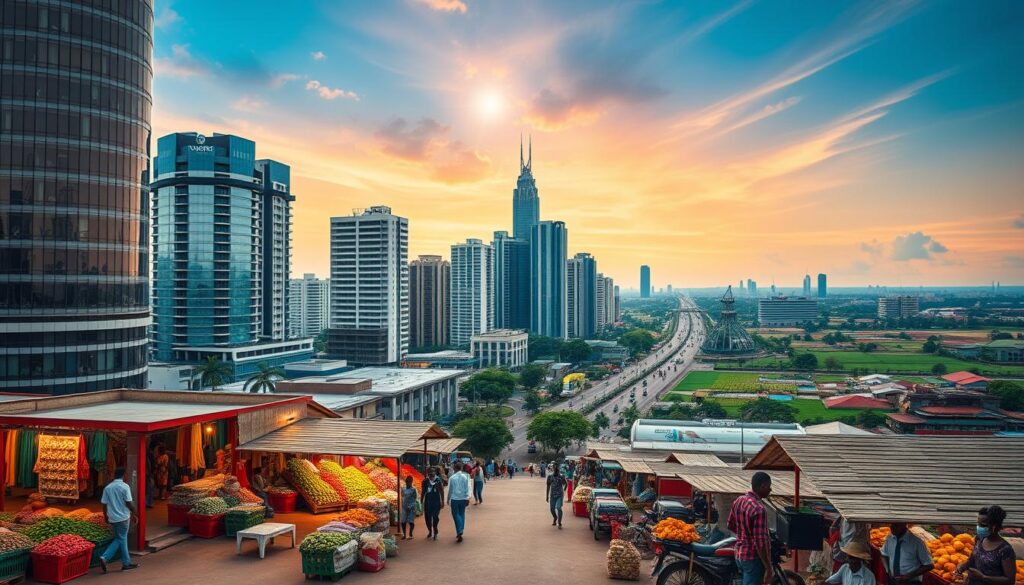
African Countries with Highest GDP
Africa, the second-largest continent, boasts several economic powerhouses that significantly contribute to its GDP. The latest estimates reveal that South Africa, Egypt, Algeria, and Nigeria lead the pack. These nations are the economic giants of Africa, with their combined GDP making up a significant portion of the continent’s total economic output16.
These countries are pivotal in shaping Africa’s economic landscape. Their combined efforts drive the continent’s economic growth, making them key players in the global economy17.
| Rank | Country | GDP (Nominal, $ Millions) |
|---|---|---|
| 1 | Nigeria | $440,834 |
| 2 | South Africa | $419,015 |
| 3 | Egypt | $404,143 |
| 4 | Algeria | $163,044 |
| 5 | Morocco | $142,866 |
Recent years have seen a shift in rankings, with Nigeria falling from the top spot to fourth place. This change highlights the need for economic diversification and resilience to external shocks1617.

The African continent is set for continued economic growth, with several countries expected to experience rapid expansion18. As these economic powerhouses evolve, policymakers and business leaders must focus on sustainable and inclusive development across the region.
Djibouti’s Strategic Economic Position
Djibouti is set to see a GDP growth rate of 6.5% in 2024, ranking it as the sixth-fastest growing economy in Africa19. Its strategic location has cemented its role as a key hub for regional trade and logistics. The country’s focus on infrastructure, including ports and free trade zones, has been crucial in attracting foreign investment. This has driven its economic growth19.
The top 10 countries with the fastest GDP growth in 2024 include several African nations, showcasing the continent’s economic potential. Djibouti’s economic developments, its GDP forecast, and its overall performance highlight its promising prospects. These factors underscore the country’s opportunities for diversification, stability, and reforms20.
| Country | 5-Year Average GDP Growth (%) |
|---|---|
| Djibouti | 6.5% |
| Rwanda | 7.7% |
| Côte d’Ivoire | 6.3% |
| Senegal | 5.9% |
| Ethiopia | 5.4% |
“Djibouti’s strategic geographic location and its focus on infrastructure development have been instrumental in driving its economic growth and establishing the country as a regional trade and logistics hub.”
Djibouti’s economic stability and ongoing reforms have further enhanced its economic prospects. This makes it an attractive destination for foreign investment and a key player in Africa’s economic landscape19.
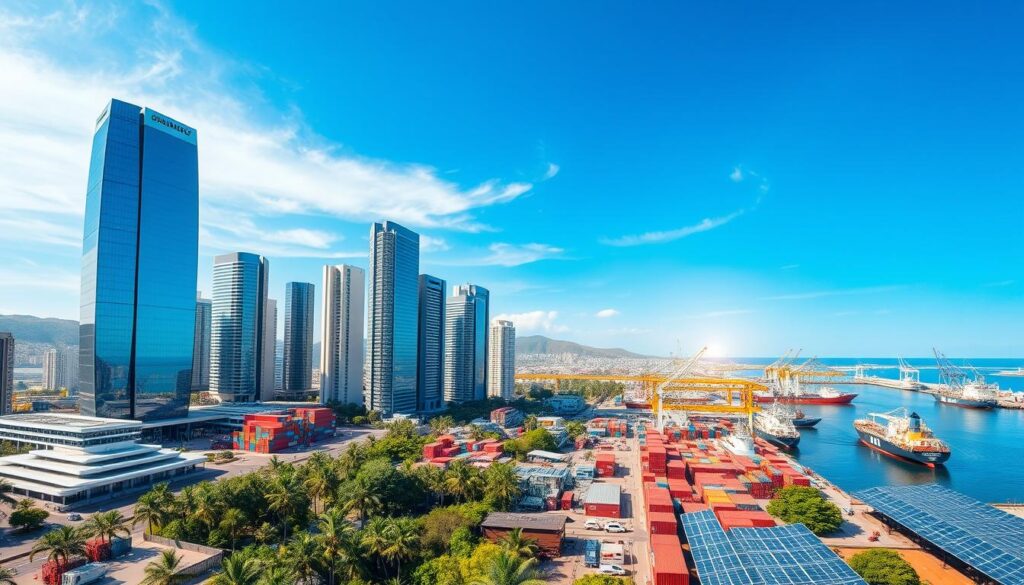
As Djibouti leverages its strategic location and diversifies its economy, it is well-positioned to maintain its strong economic performance. This will contribute to the overall growth and development of the African continent19.
The Gambia’s Emerging Economy
The Gambia, a small West African nation, is set to be one of Africa’s fastest-growing economies, with a projected GDP growth rate of 6.2% in 202421. This emerging economy has made significant strides, driven by strategic investments and policy reforms in sectors like agriculture, tourism, and services.
In recent years, The Gambia has seen a surge in economic activity. Real GDP increased by 5.3% in 2023 (2.7% per capita terms) and is expected to grow to around 5.6% in 2024-2026 (3.2% per capita terms)22. This growth is due to political stability, ongoing economic reforms, and targeted development initiatives.
| Country | 5-Year Average GDP Growth (%) |
|---|---|
| Mauritius | 5.8 |
| Ethiopia | 7.5 |
| Rwanda | 7.2 |
| Côte d’Ivoire | 6.3 |
| The Gambia | 5.9 |
The Gambia’s economic performance has been boosted by significant investments in infrastructure
projects. The $43 million Gambia Electricity Restoration and Modernization Project (GERMP) and the $47 million OMVG Regional Interconnection Project are notable examples21. These projects have improved energy access and stability, setting the stage for further growth.
Furthermore, The Gambia has strengthened its social safety net and healthcare systems. The Social Safety Net Project (P167260) allocated $30 million to support 78,422 households during the COVID-19 pandemic21. The Gambia Essential Health Services Strengthening Project received additional financing of $50 million in 2021 and $8.83 million in 202321.
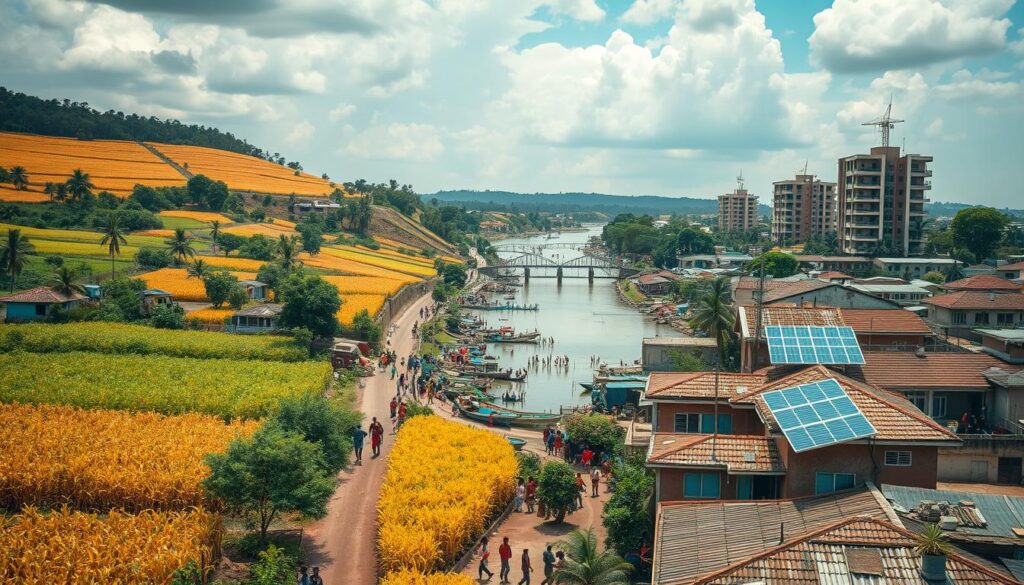
As The Gambia diversifies its economy and seizes emerging opportunities, its growth trajectory looks promising. This solidifies its position as a rising economic force in Africa.
Ethiopia’s Development Initiatives
Ethiopia, one of Africa’s fastest-growing economies, is set to continue its impressive growth, with a projected GDP growth rate of 6.2% in 202423. This growth is a result of the country’s focus on industrialization, infrastructure development, and diversifying its economy24. These efforts highlight Ethiopia’s commitment to development.
Ethiopia’s strategic location and efforts to attract foreign investment have been key drivers of its economic growth24. Since the early 2000s, the country has experienced an economic boom, with annual GDP growth averaging over 10%24. This growth has transformed Ethiopia from a mainly agricultural economy to a more industrialized and service-oriented one24.
| Country | 5-Year Average GDP Growth (%) |
|---|---|
| Rwanda | 7.5 |
| Ivory Coast | 6.7 |
| Ethiopia | 6.5 |
| Senegal | 6.1 |
| Benin | 5.9 |
Ethiopia’s development initiatives have been diverse, focusing on modernizing infrastructure and diversifying its economy24. The country has attracted significant foreign investment, especially from China, financing large-scale projects like the Grand Ethiopian Renaissance Dam24. The World Bank and International Monetary Fund have also provided substantial support to aid in Ethiopia’s reform agenda and aim to make it a lower-middle-income country by 202524.
Despite these achievements, Ethiopia still faces challenges, including youth unemployment and the potential effects of climate change on its economy23. However, its commitment to economic diversification and strategic location make it an attractive investment destination in Africa24.
“Ethiopia’s economic growth has been sustained by a gradual shift from agriculture to industry and services, although concerns about youth unemployment remain.”24
Benin’s Economic Diversification
Benin is set to be among the top 10 African nations with the highest GDP growth in 2024, showcasing its resilient economy despite various challenges25. The country’s GDP growth rate in 2023 was a healthy 5.8%, despite facing inflation shocks. This inflation doubled from 1.4% in 2022 to 2.8% in 202325. Benin’s efforts to diversify its economy, traditionally dominated by agriculture, have been key to its positive economic performance25.
Benin’s strategy for economic diversification includes investing in infrastructure, promoting entrepreneurship, and attracting foreign investment across various sectors. This includes manufacturing, tourism, and services25. These efforts have helped reduce the fiscal deficit from 5.5% of GDP in 2022 to 4.5% in 2023. Public debt has gradually increased to reach 55% of GDP in 202325.
| Economic Indicator | Benin (2022) |
|---|---|
| GDP Growth Rate | 6.25%26 |
| GDP per Capita (PPP) | $4,056.1126 |
| Manufacturing Value Added (% of GDP) | 9.82%26 |
| Unemployment Rate | 1.65%26 |
| Inflation Rate | 1.35%26 |
| Current Account Balance | -$0.73 billion26 |
| Imports of Goods and Services | $5.10 billion26 |
| Exports of Goods and Services | $3.77 billion26 |
| GDP Composition | Agriculture 27%, Services 47%, Industry 17%26 |
| Corruption Perception Index Ranking | 77/17826 |
| GDP (PPP) | $54.16 billion26 |
Despite its progress, Benin’s economy still faces significant challenges. It heavily relies on exporting unprocessed agricultural products and re-exporting goods. The informal sector accounts for almost 85% of the labor force25. The country’s poverty rate was 36.2% in 2021-2022, with an unemployment rate of 2.4% and underemployment at 72%25. Benin ranked 166th out of 191 countries on the United Nations Human Development Index (HDI) in 2020, indicating areas for improvement in life expectancy, schooling, and human capital development25.
The 2024 outlook for Benin’s economy involves addressing these vulnerabilities in its growth model. It aims to further diversify its economic base and reduce its reliance on informal labor practices25. With its strategic location, Benin is well-positioned to capitalize on emerging opportunities and continue its trajectory of economic growth and development25.
“Africa is home to eight of the world’s fifteen least diversified countries, according to the International Monetary Fund’s Export Diversification Index (2020).”27
Key Success Factors for High GDP Growth
The rapid GDP growth in top African economies in 2024 stems from several key factors. Strategic investments in infrastructure and diversifying the economy are crucial. Political stability, effective policy reforms, and attracting foreign investment also play significant roles. These elements drive economic expansion across the continent28. The development of key industries like hydrocarbons, manufacturing, and services boosts GDP growth in Africa28.
Investments in infrastructure, especially in transportation, energy, and communication, are vital. They enhance connectivity and facilitate trade and economic activities28. Diversifying the economy, moving away from natural resources, is a key strategy for sustainable growth28.
Political stability and effective policy reforms are essential for business growth. Streamlining regulations and improving the ease of doing business contribute to economic success28. Attracting foreign investment, both direct and portfolio, is critical. It brings in capital, technology, and expertise needed for growth28.
| Country | 5-Year Average GDP Growth |
|---|---|
| Ethiopia | 7.6% |
| Côte d’Ivoire | 6.8% |
| Rwanda | 6.5% |
| Senegal | 6.3% |
| Benin | 6.1% |
The growth of key industries like hydrocarbons, manufacturing, and services drives GDP growth in Africa28. Countries leveraging their natural resources, diversifying their industries, and expanding services sectors see rapid economic growth28.
“The key to achieving high GDP growth in Africa is a multi-pronged approach that addresses infrastructure, economic diversification, political stability, policy reforms, and foreign investment attraction.”
African nations can continue to drive economic prosperity by focusing on these critical success factors28. The path to sustained high GDP growth requires a comprehensive and coordinated effort across sectors and stakeholders28.
Comparative Analysis of Top GDP Growth Nations
The top African countries with the highest GDP growth rates in 2024 share common success factors. These include strategic investments, diversification, and political stability29. However, each country has its own economic structure, resource endowments, and development priorities29. For example, Senegal and Libya’s growth is heavily influenced by the hydrocarbons industry. In contrast, Rwanda and Côte d’Ivoire have more diversified economic models29. Understanding these differences is key for policymakers and investors aiming to tap into Africa’s economic potential.
| Country | 2023 GDP Growth Estimate |
|---|---|
| Rwanda | 8.24%29 |
| Ethiopia | 6.5%29 |
| Zimbabwe | 4.96%29 |
| South Africa | 0.6%29 |
| Algeria | 4.1%29 |
| Morocco | 3.18%29 |
| Tunisia | 0.42%29 |
| Ghana | 2.94%29 |
| Nigeria | 2.86%29 |
| Angola | 0.86%29 |
The data reveals Africa’s diverse economic landscape. Countries like Rwanda and Ethiopia show impressive growth, while others, like South Africa and Tunisia, face more modest projections29. This highlights the need to understand each nation’s unique success drivers. Policymakers and investors must work together to unlock the continent’s vast potential.
Some African countries have also made significant strides in social and environmental initiatives30. For example, Angola’s Kwenda Project aims to benefit 1.6 million households by 202330. The Democratic Republic of the Congo’s STEP program has improved livelihoods for over 530,000 beneficiaries, focusing on women30. These efforts show the importance of addressing both economic and social well-being in Africa.
As Africa’s economies evolve, understanding growth drivers, unique challenges, and holistic development is crucial2930. Recognizing similarities and differences among top-performing economies is key. This allows for more effective strategies to support sustainable and inclusive growth across the region.
The Role of Foreign Investments in Africa
Foreign investment has been a key driver of economic growth and development in many African countries. Sectors like infrastructure, natural resources, manufacturing, and services have seen significant benefits from increased foreign direct investment (FDI) flows31. Yet, creating an environment conducive to foreign investment, tackling barriers, and aligning investments with national goals are essential for African nations to maximize FDI’s potential.
The top 10 African countries expected to see the highest GDP growth in 202432 offer promising investment opportunities. Countries like Nigeria, Egypt, South Africa, and Kenya have long been favored by FDI, drawing investments across various sectors31. Meanwhile, emerging economies such as Ethiopia, Rwanda, and Côte d’Ivoire are gaining attention, highlighting the continent’s varied investment landscape.
| Country | GDP Growth (5-Year Average) |
|---|---|
| Ethiopia | 6.9% |
| Rwanda | 6.7% |
| Côte d’Ivoire | 6.4% |
| Benin | 6.2% |
| Senegal | 6.1% |
To attract more foreign investment, African countries should implement targeted policies and strategies. This includes simplifying regulatory frameworks, enhancing infrastructure, and investing in human capital development31. Sectors like renewable energy, agriculture, and manufacturing hold great potential for foreign investment, offering chances for diversification and sustainable growth32.
“Harnessing the power of foreign investment is crucial for Africa’s economic transformation. By creating an enabling environment and aligning investment with national priorities, African nations can unlock the continent’s immense potential.”
Despite challenges like political instability, corruption, and limited access to finance, many African countries are actively working to overcome these hurdles and attract more FDI32. The impact of foreign investment on Africa’s economic growth is profound, as it can drive innovation, create jobs, and promote sustainable development across the continent.
Future Projections for Africa’s GDP Growth
The positive outlook for Africa’s economic outlook in 2024 reflects a broader trend of improved economic performance. The African Development Bank Group forecasts that 41 countries will see increased growth rates for GDP in Africa in 2024 compared to 202333. The IMF predicts Sub-Saharan Africa’s growth rate will be 3.8% in 2024, surpassing the global average of 3.2%, making it the second-fastest growing region33. This optimism stems from ongoing investments in infrastructure, diversification of the economy, and the potential of the African Continental Free Trade Area (AfCFTA) to enhance intra-African trade and integration.
Forecasts for GDP growth in Africa indicate that Sub-Saharan Africa’s GDP growth will rise from 2.6 percent in 2023 to 3.8 percent in 202533. Additionally, inflation across African economies is expected to decrease from 7.1 percent to 5.1 percent in 202433. However, over half of African governments face external liquidity problems and unsustainable debt burdens, posing challenges to the projections for Africa’s economic performance33.
Despite the expected GDP expansion outpacing the global average, Africa still faces significant hurdles. Per capita GDP growth of 1 percent in Sub-Saharan Africa is associated with only a 1 percent reduction in extreme poverty, compared to an average reduction of 2.5 percent in other regions33. Furthermore, inequality in Sub-Saharan Africa is ranked second highest globally, following the Latin America and Caribbean region33. To address these challenges, policy actions are recommended to enhance growth and reduce inequalities including promoting macroeconomic stability, market access, and more equitable fiscal policies33.
| Country | 2020 | 2021 | 2022 | 2023 | 2024 | 5-Year Average |
|---|---|---|---|---|---|---|
| Rwanda | -3.3% | 10.2% | 7.6% | 7.9% | 7.6% | 6.0% |
| Côte d’Ivoire | 1.8% | 6.5% | 5.7% | 6.2% | 6.5% | 5.3% |
| Benin | 3.8% | 6.0% | 5.6% | 5.7% | 6.0% | 5.4% |
| Ethiopia | 6.1% | 6.0% | 3.8% | 5.3% | 5.9% | 5.4% |
| Senegal | 1.3% | 5.0% | 5.4% | 5.7% | 5.8% | 4.6% |
The continent’s long-term growth potential remains strong. Africa’s GDP growth fell 35 percent from 2010 to 201934, but the continent’s compound annual GDP growth rate averaged 3.7% from 1990 to 201934. Furthermore, Africa’s per capita income growth averaged just 1.1 percent a year over several decades34, and Africa’s average annual GDP per capita growth was 1 percent from 1990 to 201934. These factors shaping Africa’s economic trajectory suggest that with the right policies and investments, the continent can unlock its vast potential for sustained economic development.
“Africa’s top 18 cities are expected to have a combined consumer spending of around $1.3 trillion by 2030.”35
In conclusion, the predictions for Africa’s economic future are cautiously optimistic, with the continent poised for stronger growth in the coming years. However, addressing the challenges of inequality, debt, and poverty will be crucial to ensuring that the expectations for Africa’s GDP expansion translate into tangible improvements in the lives of all Africans.
Importance of Trade Relations for Economic Growth
Trade has been a key driver for growth in African economies36. The future of the U.S. trade preference program with Africa, the African Growth and Opportunity Act (AGOA), is crucial for enhancing trade relations37. The African Continental Free Trade Area (AfCFTA) is expected to boost intra-regional trade and economic integration, driving the continent’s prosperity36.
Africa currently holds about 2% of all world trade, with increasing this share to 3% potentially generating $70 billion in additional income annually37. However, Africa’s share of the U.S. import apparel market is less than 2%. Bangladesh exports more apparel to the U.S. than all sub-Saharan African countries combined37.
| Country | 5-Year Average GDP Growth (%) |
|---|---|
| Ethiopia | 7.4 |
| Rwanda | 7.1 |
| Côte d’Ivoire | 6.8 |
| Benin | 6.0 |
| Senegal | 5.9 |
Several initiatives aim to boost Africa’s trade and economic growth36. The Trade Facilitation West Africa (TFWA) program, established in 2018, aims to decrease the time and cost of goods moving along key regional corridors. It also increases private sector engagement in trade facilitation, focusing on women and small-scale traders36. The West Africa Trade and Investment Hub initiative, funded with $140 million over five years, is expected to create approximately 6,000 jobs, with a strong gender impact, targeting 50% women empowerment36. The CORDAID project, a four-year collaboration with the U.S. International Finance Corporation (DFC) and Stichting Cordaid, aims to increase access to finance for small and medium-sized enterprises and microfinance institutions in Burkina Faso, Guinea, Mali, and Sierra Leone. It anticipates generating up to $37 million in new private investments, creating over 20,000 direct and indirect jobs, and boosting export values in these countries36.
The Africa Trade and Investment (ATI) program, operated by USAID and Prosper Africa, aims to enhance trade and investment between Africa and the United States. It generates job opportunities across both regions, boosts exports and investments, fosters private sector-driven solutions, creates favorable business environments, and promotes economic opportunities for women and youth36.
“Increasing Africa’s share of world trade from 2% to 3% would generate approximately $70 billion of additional income annually.”
In conclusion, the importance of trade relations for Africa’s economic growth is immense. Various trade initiatives and programs, such as AGOA, AfCFTA, and regional trade hubs, are crucial in unlocking the continent’s economic potential. They create jobs and foster sustainable development. By strengthening trade partnerships and addressing challenges, African countries can capitalize on international trade benefits and accelerate their economic transformation.
The Significance of Infrastructure Development in Africa
Infrastructure development is crucial for the economic growth and competitiveness of top African economies38. Six of the world’s fastest-growing economies are in Africa, showcasing the continent’s vast potential. Investments in transportation, energy, and telecommunications have attracted foreign investment, facilitated trade, and promoted industrialization38. Yet, addressing the infrastructure gap and securing financing for large-scale projects are major challenges for many African countries.
With 75% of Africa’s population under 25, the need for infrastructure to support the growing population is urgent38. Africa has seven of the ten most unequal economies, but strategic infrastructure investments can help bridge this gap and foster inclusive development39. It’s predicted that 26 more African countries will double their population in the next 30 years, emphasizing the need to address infrastructure challenges.
Working with international partners and using innovative financing mechanisms will be key to speeding up Africa’s infrastructure development38. The Programme for Infrastructure Development in Africa (PIDA) has identified 51 projects needing $68 billion by 2020 and an additional $300 billion by 204038. Financing these projects will involve public-private partnerships38. The Dakar Financing Summit for Africa’s Infrastructure aimed to mobilize financial support for high-impact regional projects38. It also stressed the need to boost Africa’s domestic financial resource mobilization38, highlighting the importance of public and private sector collaboration for successful infrastructure development in Africa.






Responses